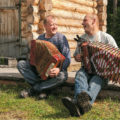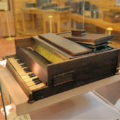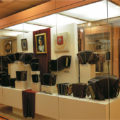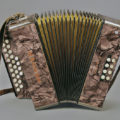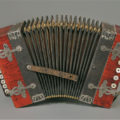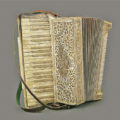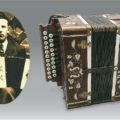The history of the Russian garmon
This instrument may seem ordinary, but no traditional Russian celebration is complete without it. People used to sing and dance, laugh and cry to the garmon. Now it can be seen and heard at any folk festival in Russia.
The name as well as the origins of the inventor of this musical instrument are unclear — it could be a Frenchman, an Italian, a German or a Chinese. According to a theory suggested by the Soviet professor of history and theory of music Alfred Mirek, the prototype of modern harmonica was created by the Czech engineer Frantisek Kirshnik. He came to Saint Petersburg to repair organs in the 1770s, at the invitation of Empress Catherine II. In his spare time, Kirshnik spent time in his own workshop searching for new ways to extract sounds, and in 1783 he submitted his creation — a harmonica, resembling a small portable piano — to the approval of Saint Petersburg’s high society.
While playing Kirshnik’s harmonica, a musician used one hand to operate the bellows embedded in the instrument’s body and pressed the buttons with his other hand. The sound was extracted by a metal flap that trembled as the air passed through it.
Kirshnik’s invention soon became popular in aristocratic salons: ladies who knew how to play clavecins and harpsichords quickly mastered the harmonica. The important advantage of the instrument was that it did not have to be tuned unlike other keyboard instruments.
One early admirers of the new harmonica was a German composer Georg Joseph Vogler. He gave credit to the new instrument invented by Kirschnik and made it popular in Europe. Over time, the instrument underwent multiple transformations, and in 1822 in Berlin, musical instrument maker Friedrich Buschmann created the world’s first hand-held harmonica.
For quite a long time Buschmann’s invention was regarded as a children toy until Austrian master Cyrill Demian lay his hands on it. He split the body of the instrument into two equal parts, put keyboards for left and right hands on them and connected the two halves by bellows. Each key corresponded to a specific chord, or accordo in Italian, which gave name to the instrument itself and it became known as an accordion. This was already a device that resembled its modern-day counterpart. On May 23, 1829, Demian patented his invention, which was the starting point for mass production and sales of accordion. Over time, the instrument became widely popular across various European countries, primarily in Italy, France and Germany. One piece of such German harmonica became the ancestor of the famous Russian garmon, or garmoshka.
In 1839, a gunsmith from Tula Ivan Sizov visited a trade fair and heard deep, melodious sounds produced by a curious instrument brought from overseas. He bought it for 40 roubles, an immense sum at that time, quickly learn its design, and made his own harmonica using it as an example. He made several copies for his friends and family, and then started producing instruments for sale. The business had a flying start, and at the next year’s Maslenitsa festival the whole district danced not to the well-known balalaika, but to the new garmon.
Ivan Sazov’s work drew interest from an industrialist Timofey Vorontsov, who later became founder of Russia’s first garmon factory. By 1851, Tula was home to six such fabrics. From that city the instrument made its way to the nearby regions of Ryazan, Orel and Pskov.
When creating his own garmon, a master would adjust its features to better fit the nature of folk music that was popular in that particular area. In order to make the sound of the instrument and the singer’s voice complement each other, the artisans began experimenting with tonalities. That is why there are so many varieties of the instrument in Russia: there were characteristic local versions of garmon made in Vyatka, Vologda, Saratov, the town of Shuya or a village of Livny (the “livenka”). This is by no means a complete list of Russian garmons. In almost every province, the masters created their own ones and tried to make them as elegant as possible. For instance, artisans of Bologoye village decorated musical instruments with carved copper, fancy cloth and plate glass. The Bologoye garmon had basses and a set of major and minor chords. Its sound resembled that of the instruments used by Italian strolling musicians.
Soon appeared Garmons with two rows of buttons on the right-hand side, with each row corresponding to a certain sound sequence (the so-called “Russian Viennese garmon”). At some point the third row of buttons was added.
The garmon was played not only in villages, on the streets and at fairs. Over time, they found their place in classical concert halls. An inventor from Tula Nikolay Beloborodov in the 1880-s created a version of the instrument specifically designed for being part of an ensemble. The peculiar sound of that garmon eventually allowed the great Russian composer Pyotr Tchaikovsky to include it in a symphony orchestra for the first time.
In 1928, a themed exhibition was held in Moscow for the sake of improving the production of garmons. As the result, a rigid assortment and standards for produced models appeared. The quality of the produced garmons and their artistic and stylistic features were thoroughly monitored at the competitions held among the masters. Different musical instruments were played behind a closed curtain and the jury determined the sound quality by listening to them anonymously. Masters from Tula were frequent winners of such events.
The production of harmonies did not stop even in during the hard times of the Great Patriotic War. Initially, the producers thought that at the terrible time for the country nobody cared about music, but suddenly they began to receive hundreds of letters from the army in which soldiers asked them for garmons, because “It is easier to fight while singing”, they wrote. There was even a slogan: “A garmon for every squadron!” Already in the summer of 1941, around 12,000 garmons were dispatched to the front to raise the morale among the soldiers, and in autumn of that year 60,000 more. Thus the garmon became a fighting friend of Soviet soldiers and “walked” with them on all war-time roads.
There are multiple anecdotes about war involving garmons. For instance, in May 1942 scouts saw two motorboats on Western Dvina (Daugava) river and immediately opened fire. They hit one boat straight, and in the second one, they found an accordion made by Hohner, a famous German company. Hitler’s soldiers used this instrument during their propaganda trips to the villages they captured. The instrument was given to the Belarus Song and Dance Company with an inscription: “Play it cheerfully, and may its sounds roar as a funeral march for Hitler”. When the war ended, the instrument was consigned to a museum.
Later, veterans recalled that the only thing that helped them survive through the wartime was songs and ditties sung to the sound of garmon. The old songs such as “Barynya” (“Lady”) and “Tsiganochka” (“Gypsy”), as well as the legendary “Katyusha”, one of the symbols of the Great Patriotic War, lifted the wounded soldiers into battle.
One can only wonder at the fantasy of the masters who created garmoshkas. For example, there are instruments as high as a human, designed for two musicians to play them together, and they have survived to our days. There are also tiny instruments, the size of several matchboxes. There is a “turtle” garmon, quite an eccentric musical instrument often played by circus clowns. One can find a garmon in the form of a boot or a skullcaps, to name just a few peculiar examples.
Currently, there are four harmonica museums in the world: in Germany, Italy, Russia and the USA. The Alfred Mirek Russian Accordion Museum boasts a unique collection that professor Mirek himself collected during half a century. In 1997, he donated 200 rare exhibits of this musical instrument to the city of Moscow.
The sound of a garmon is often compared to the singing of a nightingale, a rather unattractive bird capable of producing most magnificent warbles. This instrument is considered the heart of a Russian person, especially the one living in a village. Now there are not so many people left who can play the garmon masterfully. To preserve the original Russian musical traditions, to pass them on to future generations, numerous thematic festivals are organized around the country, gathering numerous participants, some of whom come from different European countries.
K.Lenskaya

